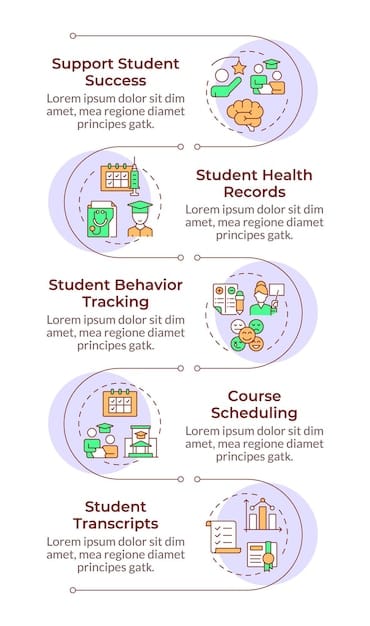2025 Federal Education Budget: Impact on College Affordability

Advertisements
The 2025 federal education budget proposes significant changes in student aid, grant programs, and institutional funding, potentially reshaping college affordability for US students through increased Pell Grant allocations, expanded work-study opportunities, and targeted support for underserved populations, though ongoing debates about specific allocations remain.
Understanding how the new federal education budget for 2025 impacts college affordability for US students is crucial for prospective students and their families. This pivotal budget, crafted amidst a landscape of evolving economic pressures and educational priorities, promises to redefine the financial pathways to higher education across the nation. What exactly does it entail, and how will these changes ripple through the lives of millions aspiring to a college degree?
decoding the 2025 federal education budget
The proposed federal education budget for 2025 represents more than just a set of numbers; it’s a strategic blueprint aiming to address some of the most persistent challenges in higher education. At its core, the budget seeks to balance fiscal responsibility with the imperative to ensure that higher education remains accessible and affordable for all US students, regardless of their socioeconomic background. This involves a complex interplay of funding for direct student aid, institutional support, and various programmatic initiatives designed to enhance educational outcomes.
One of the primary objectives embedded within the budget is an increased focus on need-based financial aid. Policymakers recognize that the escalating costs of tuition, housing, and living expenses have created significant hurdles for many families. Therefore, direct student support mechanisms are often at the forefront of these discussions, aiming to alleviate the immediate financial burden on students. However, the budget also delves into broader systemic issues, such as bolstering institutional capacity to serve diverse student populations and fostering innovation in educational delivery.
key legislative priorities
The legislative priorities underpinning the 2025 budget are multifaceted, informed by ongoing dialogues between educational stakeholders, economists, and government officials. These priorities aim to create a more equitable and effective higher education system.
- Enhanced Pell Grant Funding: A consistent cornerstone of federal student aid, the Pell Grant program is expected to see a significant boost, aiming to increase the maximum award amount and expand eligibility.
- Work-Study Program Expansion: The budget includes provisions to broaden federal work-study opportunities, allowing more students to earn money for educational expenses while gaining valuable experience.
- Support for Minority-Serving Institutions (MSIs): Increased allocations are earmarked for Historically Black Colleges and Universities (HBCUs), Tribal Colleges and Universities (TCUs), and other MSIs, acknowledging their critical role in educating diverse student populations.
Beyond direct financial aid, the budget also emphasizes investments in areas like academic counseling, mental health services, and career development, recognizing that affordability is not just about tuition, but also about the comprehensive support systems that enable student success. The proposed budget attempts to balance immediate financial relief with long-term investments in the educational infrastructure. These systemic changes are intended to foster a more resilient and equitable higher education landscape for generations to come, addressing the root causes of educational disparities rather than just their symptoms.
impact on direct student financial aid
The cornerstone of college affordability for many US students lies in the availability and adequacy of direct financial aid. The 2025 federal education budget proposes several pivotal changes to these programs, each with the potential to either significantly ease or, in some cases, marginally impact the financial burden of pursuing higher education. Examining these specifics is crucial to understanding the nuanced effects of the budget.
The Pell Grant, a foundational element of federal student aid, is under particular scrutiny in the 2025 budget. There are strong indications of an increase in the maximum Pell Grant award. This adjustment is not merely an incremental change; it reflects an understanding that inflation and the rising cost of living have eroded the purchasing power of previous grant amounts. A substantial increase in the maximum award could mean thousands of dollars more for eligible students, directly reducing the need for loans and improving overall affordability for low- and middle-income families.
changes to loan programs and interest rates
Beyond grants, federal student loan programs are also subject to potential modifications within the 2025 budget. These changes can have a profound effect on the long-term financial health of graduates.
- Interest Rate Adjustments: Discussions around federal student loan interest rates are ongoing. Any downward adjustment, even modest, could save borrowers thousands of dollars over the life of their loans.
- Income-Driven Repayment (IDR) Enhancements: The budget may include provisions to further streamline and expand IDR plans, making loan repayment more manageable for graduates with varying income levels.
- Loan Forgiveness Initiatives: While broad-stroke forgiveness remains a topic of debate, targeted loan forgiveness programs for specific professions (e.g., teaching, public service) or circumstances (e.g., disability) could see increased funding.
The federal work-study program is another critical component receiving attention. The 2025 budget aims to expand access to this program, allowing more students to earn money directly through on-campus or community service jobs. This not only provides financial relief but also offers valuable professional experience, reducing reliance on external employment that might detract from academic focus. These combined changes to grants, loans, and work-study programs underscore a concerted effort to recalibrate federal support, making college a more attainable reality for a wider segment of the US student population. The emphasis on grants over loans, in particular, signals a shift towards reducing student debt burdens from the outset, a move widely supported by educational advocates and students alike.
institutional funding and its ripple effects
While direct student aid directly impacts individuals, the federal education budget also allocates significant funding to institutions themselves. These institutional funds, though less visible to the individual student at first glance, create profound ripple effects that influence tuition costs, program offerings, and the overall quality of education, thereby indirectly but powerfully affecting college affordability. The 2025 budget recognizes that a healthy and well-supported educational infrastructure is fundamental to keeping higher education accessible.
A key area of institutional funding in the 2025 budget is support for research and development. Federal grants for scientific and academic research not only advance knowledge but frequently subsidize the operations of universities, allowing them to allocate other revenues away from basic overhead and towards student-centric services or tuition mitigation. Furthermore, funding for facilities upgrades, technology enhancements, and faculty development directly improves the learning environment and the quality of instruction, justifying, in part, the cost of attendance while aiming to prevent sharp tuition increases.

support for specialized programs and underserved communities
The budget also includes targeted funding for specific types of institutions and programs that serve particular communities or fields of study. This directed support has a specific impact on affordability for certain student demographics.
- STEM Initiatives: Investments in Science, Technology, Engineering, and Mathematics (STEM) programs provide resources for state-of-the-art labs and equipment, making these often expensive fields more accessible for students.
- Rural College Support: Financial aid for colleges in rural areas often addresses unique challenges these institutions face, like limited local tax bases, helping them maintain competitive tuition rates.
- Community College Grants: Bolstering community colleges through federal grants can help keep tuition low at these institutions, which serve as a critical, affordable entry point into higher education for millions.
This institutional funding also extends to capacity building at Minority-Serving Institutions (MSIs). By providing these institutions with dedicated funding, the budget aims to enhance their ability to offer high-quality education, expand their programs, and retain students, ultimately making higher education more affordable and attainable for a diverse range of students who might otherwise face greater barriers. The indirect effects of these institutional allocations are crucial; by strengthening the financial health and programmatic offerings of colleges and universities, the federal budget creates an environment where institutions are less compelled to raise tuition excessively, thus contributing to overall college affordability.
implications for specific student demographics
The blanket terms “US students” often obscure the diverse financial realities and needs of different student populations. The 2025 federal education budget, while aiming for broad impact, carries specific implications for various demographic groups, recognizing that affordability is not a uniform challenge. Understanding these targeted effects is essential to grasping the budget’s full scope.
For low-income students, the anticipated increase in Pell Grant funding stands as the most significant development. As a direct grant that does not need to be repaid, an enhanced Pell Grant directly reduces the amount of loans these students might need to take on, thereby cutting future debt burdens. This, coupled with potential expansions in work-study opportunities, offers a more immediate pathway to affordability. These measures are designed to act as vital lifelines, ensuring that financial constraints do not become insurmountable barriers to higher education for those with the fewest resources.
impact on first-generation and rural students
First-generation students and those from rural areas often face unique challenges in accessing and affording college. The 2025 budget addresses some of these specific hurdles.
- Targeted Outreach and Support Programs: Increased funding for programs that provide academic and financial counseling to first-generation students can make the college application and enrollment process less daunting.
- Rural College Infrastructure: Investments in rural colleges and universities, through institutional grants, can help these institutions provide competitive education at lower costs, enabling students to stay closer to home if desired.
- Digital Connectivity Initiatives: Ensuring that students in remote areas have adequate internet access, often supported by federal grants, is crucial for engaging with online learning and necessary resources.
For students from minority backgrounds, particularly those attending Minority-Serving Institutions (MSIs), the budget’s emphasis on institutional support for these schools is critical. This funding can lead to better resources, more diverse faculty, and enhanced retention programs, all of which contribute to a more affordable and successful college experience. Furthermore, the budget’s potential impact on student loan interest rates and the expansion of income-driven repayment plans can provide significant long-term relief for all student borrowers, but especially for those who may face greater challenges in securing high-paying employment immediately after graduation. These targeted provisions underscore a recognition that a truly equitable education system must address the varied needs of its diverse student body, fostering greater affordability across the spectrum.
potential challenges and criticisms
While the 2025 federal education budget largely aims to enhance college affordability, no comprehensive financial plan is without its potential challenges and criticisms. A balanced assessment requires acknowledging these concerns, ranging from debates over specific allocations to broader systemic issues that the budget might not fully address. These critiques often highlight areas where implementation could falter or where the proposed measures might not achieve their intended widespread impact effectively.
One of the primary criticisms often leveled against federal education budgets is the perennial issue of underfunding. Even with proposed increases, some advocates argue that the allocated amounts are still insufficient to truly keep pace with the rampant rise in tuition costs and living expenses. This gap means that despite expanded grants or improved loan terms, many students may still face significant financial shortfalls, necessitating reliance on private loans or extensive part-time work, which can impede academic progress. The political nature of budgetary decisions also means that proposed increases might be subject to negotiation and reduction before final approval, potentially watering down the positive impacts.
implementation hurdles and long-term sustainability
Beyond the immediate financial figures, there are also concerns surrounding the practical implementation of new programs and the long-term sustainability of the budget’s initiatives.
- Bureaucratic Delays: The rollout of new grant programs or changes to existing ones can often be slow due to bureaucratic processes, meaning students might not feel the full benefits immediately.
- State-Level Funding Disparities: Federal funding, while significant, doesn’t always fully compensate for drastic cuts at the state level, creating uneven affordability landscapes across different states.
- Inflationary Pressures: Future inflation could quickly erode the purchasing power of any increased grant amounts, requiring continuous and often politically challenging adjustments to maintain impact.
Another area of concern revolves around whether the budget adequately addresses the root causes of rising college costs, such as administrative bloat, excessive spending on non-academic amenities, and the decreasing public funding for higher education at the state level. Critics argue that without addressing these fundamental drivers, federal aid acts as a temporary bandage rather than a lasting solution. Furthermore, the budget’s emphasis on certain areas might inadvertently neglect others, leading to an imbalance in support across disciplines or types of institutions. These challenges underscore the complexity of truly reforming college affordability and highlight the ongoing need for nuanced policy debates and robust oversight.
comparative analysis: 2025 vs. previous budgets
To fully appreciate the significance of the 2025 federal education budget, it’s insightful to conduct a comparative analysis with previous budgetary cycles. Such a review reveals trends, shifts in priorities, and the cumulative impact of federal policy on college affordability over time. This historical context underscores whether the 2025 budget represents a genuine turning point or a continuation of existing trajectories in federal support for higher education.
Historically, federal education budgets have often struggled to keep pace with the escalating costs of tuition and living expenses, leading to a growing reliance on student loans. While Pell Grants have seen incremental increases, their purchasing power relative to tuition has, at times, diminished. Previous budgets often focused on loan programs as the primary mechanism for affordability, sometimes expanding loan limits rather than significantly boosting grant aid. The 2025 budget appears to signal a more deliberate shift towards grant-based aid, aiming to reduce the initial debt burden rather than just managing it post-graduation.
trends in federal investment and priorities
Several key trends emerge when comparing the 2025 budget with its predecessors, indicating evolving federal priorities in higher education.
- Shift to Grant-Based Aid: While previous budgets often amplified loan programs, the 2025 budget shows a stronger commitment to increasing non-repayable Pell Grants, suggesting a policy pivot.
- Enhanced Support for Underserved Institutions: There’s a notable and sustained increase in dedicated funding for MSIs, HBCUs, and TCUs, a recognition of their unique contributions and historical underfunding.
- Focus on Student Well-being: Beyond direct financial aid, the 2025 budget places a greater emphasis on funding for student support services, including mental health and career counseling, reflecting a more holistic view of student success.
Moreover, past budgets often faced political gridlock that stalled or diluted proposed increases, particularly concerning financial aid programs. The 2025 budget, while not immune to political machinations, appears to have stronger bipartisan support for certain fundamental affordability measures, potentially leading to a more stable and predictable funding environment. This comparative lens highlights that the 2025 federal education budget is not just another annual allocation; it reflects a potentially significant policy evolution, striving to address long-standing affordability challenges with more direct and impactful solutions compared to some of its predecessors, aiming to lay a stronger foundation for accessible higher education for all US students.
navigating the new financial aid landscape
For US students and their families, understanding how to effectively navigate the evolving financial aid landscape shaped by the 2025 federal education budget is paramount. While the budget aims to increase affordability, accessing those benefits requires active engagement and informed decision-making. The changes, both in existing programs and potentially new initiatives, necessitate a proactive approach to financial planning for college.
The first crucial step for all prospective and current college students is to meticulously complete the Free Application for Federal Student Aid (FAFSA). The 2025 budget’s potential enhancements to Pell Grants and other federal programs mean that eligibility thresholds or maximum award amounts may change, making it more vital than ever to ensure this application is submitted accurately and on time. Early submission can sometimes be advantageous, as some federal aid is awarded on a first-come, first-served basis, subject to fund availability. Thoroughly understanding the FAFSA and its requirements is the gateway to unlocking federal support.
strategies for maximizing aid opportunities
Beyond the FAFSA, several strategies can help students maximize their financial aid opportunities under the new budget, leveraging both federal and other available resources.
- Research State Aid Programs: Many states offer their own grant and scholarship programs, which might be influenced or complemented by federal guidelines. Students should investigate their state’s specific offerings early.
- Explore Institutional Scholarships: Colleges and universities often have their own scholarship funds, some of which are need-based and others merit-based. Applying directly to these institutional scholarships can significantly reduce costs.
- Consider Work-Study: With potential expansions in the federal work-study program, students should actively inquire about and pursue these opportunities, which offer both income and valuable experience.
Furthermore, students and families should maintain open communication with the financial aid offices of their chosen institutions. These offices are invaluable resources for understanding the intricacies of aid packages, appealing decisions, or exploring special circumstances that might qualify for additional support. The 2025 budget strives to create a more accessible higher education system, but the onus remains on students to actively seek out and apply for the aid available to them. Staying informed about the budget’s final approved provisions and working closely with financial aid professionals will be key to successfully leveraging the improved affordability pathways it aims to establish.
| Key Aspect | Brief Impact Description |
|---|---|
| 💰 Increased Pell Grants | Directly reduces out-of-pocket costs and loan reliance for eligible students. |
| 📚 Institutional Funding | Supports university operations, potentially limiting tuition hikes and enhancing resources. |
| 🤝 Expanded Work-Study | Offers more opportunities for students to earn money and gain experience while studying. |
| 📈 Loan Program Adjustments | Potential changes to interest rates and repayment plans make loans more manageable. |
frequently asked questions about the 2025 federal education budget
▼
The primary goal is to significantly improve college affordability for US students. This is largely achieved through proposed increases in direct financial aid, particularly Pell Grants, and enhanced support for institutions that serve diverse student populations, aiming to reduce the financial burden on students and families.
▼
The 2025 budget is expected to propose a substantial increase in the maximum Pell Grant award. This aims to restore some of the grant’s purchasing power, helping more low- and middle-income students cover tuition and living expenses without resorting to extensive borrowing, thereby enhancing overall affordability directly.
▼
While specific details are subject to final approval, the budget discussions indicate potential adjustments to federal student loan interest rates and further enhancements to income-driven repayment plans. Targeted loan forgiveness programs for certain professions may also see increased funding, though broad forgiveness remains a separate debate.
▼
Institutional funding, though indirect, plays a crucial role. It supports universities’ operational costs, research, and specialized programs, potentially preventing tuition hikes. Furthermore, dedicated funds for Minority-Serving Institutions and rural colleges improve their resources, making quality education more accessible and affordable for diverse student bodies.
▼
Students should prioritize completing the Free Application for Federal Student Aid (FAFSA) accurately and promptly. Additionally, they should research state-level aid programs, explore institutional scholarships, and inquire about federal work-study opportunities with their college’s financial aid office to maximize all available support.

conclusion
The 2025 federal education budget stands as a critical juncture for college affordability in the United States. Through its proposed increases in direct student aid, particularly the Pell Grant, and strategic investments in educational institutions, it aims to dismantle some of the financial barriers that have long impeded access to higher education for countless US students. While challenges and criticisms remain, particularly regarding the long-term sustainability of funding and the broader issue of rising college costs, the budget signals a concerted effort to prioritize affordability and equity. For students, proactive engagement with financial aid resources and a clear understanding of the new landscape will be crucial in leveraging these federal provisions to achieve their academic aspirations with reduced financial burden.





